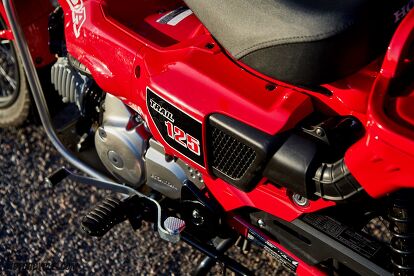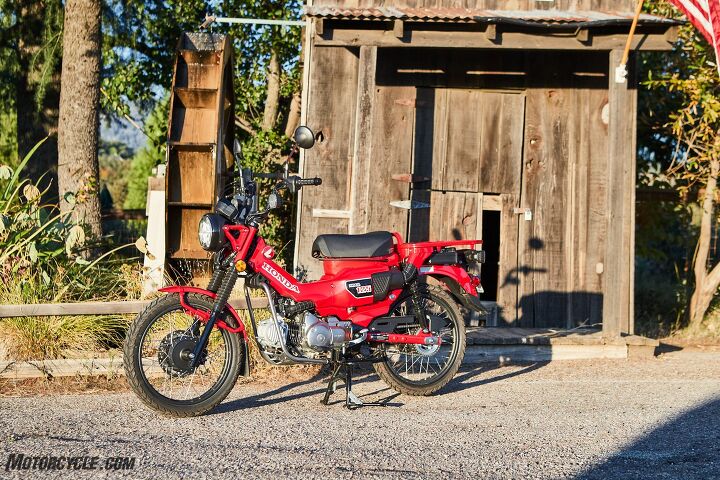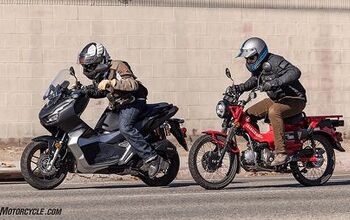2021 Honda Trail 125 Review - First Ride

A nostalgic rip down memory lane
The re-introduction of the Honda Trail in the United States marks a homecoming of sorts for a model that was, and still is, very special to American Honda and many Americans that grew up riding it. While attending the introduction of the 2021 Honda Trail 125 in Julian, California a few weeks ago, I had the chance to see the new model sat next to a well-preserved, but used 1985 Trail 110. The resemblance is commendable. From the dimensions themselves, to small details like the large hub on the front wheel that looks reminiscent of a drum despite the new model’s disc brakes (front and rear), Honda has done a really great job making the 2021 model a spitting image of the Trails imported to the US in the ‘80s.
2021 Honda Trail 125
| Engine | 14.0/20 |
| Suspension/Handling | 7.5/15 |
| Transmission/Clutch | 6.5/10 |
| Brakes | 8.0/10 |
| Instruments/Controls | 2.5/5 |
| Ergonomics/Comfort | 8.0/10 |
| Appearance/Quality | 8.5/10 |
| Desirability | 7.5/10 |
| Value | 7.0/10 |
| Overall Score | 69.5/100 |
During our time in the mountains, we strung our poles and attempted to fish, nocked a few arrows, and blasted down back roads, fire roads, and even the odd two-track trail. It was a pleasant example of the duty Honda foresees its latest mini-moto doing. Like the original, American Honda would love to see one on the back of every motorhome, parked aside every barn, and tucked away in every garage for quick jaunts about town. Before we get into the details about the 2021 Honda Trail 125, let’s take a look back at the story of how it came about.
A Bit of History
The Honda Trail lineage dates back to 1961, but it was the year prior, in 1960, that the all-terrain vehicle’s story began. Just a year after Honda had established itself in the United States sales were growing – just not at the 1,000 units per month that Honda had hoped for. One thing was certain, they would have to adapt and invest in order to survive and thrive in the U.S. While there is a much larger and broader story about Honda’s humble beginnings stateside, the Trail 50’s fits in right at the beginning.
One late night in Los Angeles, the then sales manager of the fledgling company, Jack McCormack sat looking through a sales report. He was astonished by the amount of Honda 50s being sold by an unsuspecting dealership in Boise, Idaho. That dealership was run by Herb Uhl. A sportsman himself, Uhl had been modifying the Honda 50s for better use off-road and was selling them to like-minded individuals – of which there were a lot. The modified Hondas were useful for all sorts of outdoor tasks including hunting, fishing, and work around ranches and farms. Uhl’s customizations were fairly straightforward, and included removing the leg guards and any other unnecessary bits, mounting knobby tires, and adding a larger sprocket to the rear wheel.
McCormack phoned Uhl to investigate the anomaly and later asked that one of these Honda 50 “Trails” as they were, be sent to the headquarters in Los Angeles. “It was a brilliant little machine,” McCormack said. “It worked so well because it was light, and with the automatic clutch, you could climb logs. To do that on a big bike, you had to have a certain amount of skill. I saw lots of possibilities for something like Herb was doing, selling it as a bike that you could go in the woods and hunt or fish with.”
McCormack sent the bike to American Honda’s parent company in Japan, with a request to build a production version of Uhl’s off-road adaptation and by March 1961, the CA100T Trail 50 was offered to Honda dealers across America.
Then and now
Over the years, different variations of the Trail – also known as the CT – came about. A few years after the Trail 50 was produced, Honda debuted the Trail 90 in 1964, which had a larger 87cc engine and a new four-speed automatic transmission with a centrifugal clutch. This model also received a high fender and an air intake that was routed higher to protect the engine from water during stream crossings.
Two years later, the name was changed to the CT90 Trail 90, which brought with it numerous upgrades, including an all-new 89cc engine with a lightweight, aluminum-alloy head that used a reliable chain-driven, overhead camshaft. The dual-rear-sprocket arrangement was replaced by a selectable reduction gear in the transmission, a feature Honda called “Posi-Torque” that effectively gave the CT90 an eight-speed gearbox – ideal for crawling over all types of terrain – with the flip of a lever on the transmission case. Dry weight was claimed to be 179 pounds, and it was said to produce 7 horsepower at 8,500 rpm. A telescopic fork was introduced in 1969, and in 1970, the folding handlebar was added. In ‘74, the Trail 90 was equipped with turn signals, making it street-legal across the United States.
The Trail 70 also made its way into history during that time. Introduced in 1969, the Trail 70 was sold until 1982 as the quintessential playbike for many youths of the time period. The mini-bike based platform was a mashup of something similar to the Z50 and larger CT machines.
In 1981, the CT110 was introduced with a 105cc engine guarded by steel bars on either side to help protect the low slung engine. With more grunt than ever, the CT110 was a popular machine with those familiar with the Trail series and was sold in the U.S. until 1986. The model continued on in much of the world and possibly hung on longest down under, where the Australian postal service used them as mail carriers as recently as 2010.
Now and then
For 2021, we continue to see Honda’s MiniMoto lineup grow with the reintroduction of the Trail. This latest version shares the 125cc two-valve single overhead cam engine found in the Grom, Monkey, and Super Cub. The Trail 125 also shares the automatic centrifugal clutch of the Super Cub in addition to many other features. In fact, it’s probably easier to go over the differences rather than the similarities.
Compared to the latest Super Cub, the Trail 125’s wheelbase is a half inch longer. A new pivot plate has been added, and the head pipe has been reinforced for better stability on bumpy terrain. Soaking up those bumps is 4.3 inches of travel from the front suspension (0.4 inches more than the Super Cub), while the rear shocks remain almost unchanged from the Super Cub with 3.4 inches of travel. Ground clearance is increased to 6.5 inches, and the seat height is slightly taller at 31.5 inches. However, with the step-through design, the Trail 125 and the Super Cub are both great options for newer and shorter riders.
In order to achieve the desired performance characteristics, the Trail 125 was given a larger 39-tooth rear sprocket (up three from the Super Cub) and a longer exhaust and intake tract to tune the Trail for more low- to mid-range power. With its history as a workhorse, it should be no surprise to see that the large and robust rear rack measures 16 by nearly 19 inches and boasts a max cargo load of 44 pounds(!) – which we know, if Honda is willing to put that number on the carrier, it can likely handle much more.
But does the Honda Trail 125 still hold up as the useful practical machine it had once been so many years ago? With modern machines like ATVs and UTVs taking the place of many outdoor activities including work around the ranch and hunting, it’s hard to view the little two-wheeler as a rational option for those chores specifically. Is the Trail still trail-worthy or best kept cruising comfortably down memory lane?
Down the trail
I can report the Trail 125 is happy to do most anything you would like it to do and, if one chooses, can still very much be the workhorse it once was. Like the original, the Trail 125’s automatic clutch and four-speed transmission make this one of the least intimidating two-wheelers on the market for virtually anyone – perhaps even more so than its Super Cub sibling simply because there is less pretty plastic to worry about should you have a tip over.
During the introduction we cruised through some epic fall scenery via back roads and highways near Lake Cuyamaca where we would later spend lunch. It was quickly evident that the Trail 125 won’t be getting you anywhere in much of a hurry. I saw a top speed of 51 mph on flat surfaces; though during a long downhill, I managed an eye-watering 62. Should you find yourself faced with an incline of any degree, do plan to lose speed. How quickly will, of course, depend on the steepness and may require a downshift. Out of the four gears, fourth is more of an overdrive, as it doesn’t have much left in the gearing department torque-wise at this point.
With modern niceties like disc brakes and fuel injection, the Trail is a decidedly modern machine, albeit simple. You have ABS on the front wheel only, while the rear is readily lockable upon a firm press of the brake lever. I found the front brake to be plenty strong for stopping the little machine, and since the Trail 125 carries much of its weight rear-biased, both brakes do a confident job of getting the bike stopped in a hurry. Even in a panic situation when a car pulled out in front of me as I was cruising at about 40 mph or so, I was able to get the bike stopped in time rather than splattering myself across the side of the offending young lady’s SUV.
The seating position is comfortable for 5-foot 8-inch me, and even for the shortest of folks, the step-through design should be confidence inspiring. On the MO scales, the 2021 Trail 125 weighed in at 257 lbs. Again, most of that weight is set toward the rear of the machine, and its fairly low center of gravity makes it easy to handle. Lock to lock, the Trail 125 is capable of tight maneuvers should you find it necessary. Around the footpegs things get tight, though. It was hard to keep my left heel off of the toe/heel shifter when I wanted to, and since I’m used to a standard motorcycle, I found myself shifting normally anyway. This is something you might just get used to. On the right, Honda decided to include a kick starter! It’s cool, except now anyone with a size 9 or larger foot will likely be encumbered by it, too.
Off-road, the bike is ready for just about anything as long as you take it slow-ish. The Trail will blow through the stroke and bottom if you try hucking it off any sweet jumps or carry a pace too fast for its springs to recover from. That said, riding the Trail off-road is a lot of fun and allows you to enjoy your surroundings as you meander along. A lot of the same things that make this motorcycle approachable on-road transfer to its polite off-road character. The 17-inch spoked tube-type wheels track straight and easily roll over bumps, and the soft suspension soaks them up with comfort and ease. Not having a clutch is another huge plus for first time riders bouncing down trails.
The Trail 125 is pretty good overall, but can it hold a candle to the work ethic of its predecessors? Around town, the Trail 125 is just fast enough to get off the line before your typical inattentive driver. If said driver were to have any sort of immediacy to their acceleration, most will probably win in a light-to-light drag. Again, the top speed shown on the small (and unfortunately hard to see) LCD dash was 51 mph around town, and it doesn’t get there in a hurry.
A trip to the local hardware store with a “milk crate” strapped to the back allowed me to put around 20 pounds of stuff in the crate easily and the automatic transmission came in handy when I had to buy an 8-foot by 2-foot panel of metal stucco netting rather than the 10 by 12-inch amount that I needed to get the job done.
Remember our friend Herb Uhl? He was quoted in a (self-serving) ad as follows, “It’s a modern Sportsman’s best friend all the way!” Uhl of Herco Engineering in Boise Idaho says. “Never, never… will I go hunting without my new Trail ’50’. Recently I packed out two strapping deer from Idaho’s toughest timberland and witnessed two more hunters bringing in four more – also on Trail ’50’s (one of them was a 5-point 250 lb, trophy buck). I was able to scout ten times as much hunting area as on foot, also used my ’50’ for hauling water, dragging firewood logs, and general around-camp errands. This year’s hunting was the best yet… thanks mainly to a little critter called a Honda Trail ’50’!”
Being from Illinois, I grew up around deer hunting my entire life. I’ve even spent some time in a blind myself. Herb’s quote made me curious, could the Trail 125 pull a 250-pound dead animal out of the woods?
Headquartered in southern California’s sprawling metropolis, I did my best to deliver the most accurate recreation possible when the thought popped into my head on a weekday morning. The experiment involved a rope, tarp, 100-pound sand bag and a 150-pound friend. The Trail effortlessly harvested him from the corner of his flat, mostly dirt-strewn back yard. After increasing the weight to 340 pounds, the Trail was just barely able to pull the load across smooth ground. If we factor in mud, dead leaves, trees, etc., I think the Trail 125 could easily pull a 250-pound 5-pointer out of the woods with relative ease. But like I mentioned earlier, most folks are probably using something of the four-wheeled variety these days which would be much easier.
As for other duties the old guard used to handle, like bouncing around fence lines on the ranch, carrying a fisherman and his poles to the lake, or scooting around the campsite to gather firewood or supplies, the new kid on the block will do so with aplomb.
In 1961, the Honda Trail 50 cost $275. The 2021 Honda Trail 125 retails for $3,900. If we consider the rate of inflation, this new model should be about $2,400. When we start trying to justify the purchase the question arises: Is it more practical than a scooter around town? More practical than something like the ADV 150? The ADV 150 retails for $4,300, is capable of dirt roads, has lockable storage and more power from its larger engine. I would say the Trail certainly has its advantages off-road over the Honda adventure scooter and is probably easier to strap to an RV, but otherwise the question remains.
The nostalgia factor is strong with this one, but is it enough to pry open the wallets of the young, old, and everyone in between like it seemingly once was? Only time will tell.
2021 Honda Trail 125
+ Highs
- The spitting image of its predecessor
- Easily maueverable
- Large wheels make for easy trail duty
– Sighs
- You won’t be getting anywhere too quickly
- LCD display is hard to see in most lighting situations
- A little pricey
In Gear

Helmet: Bell Moto 3 $300
- Jacket: REV’IT! Westport (discontinued)
- Gloves: Racer Mickey $120
Boots: REV’IT! Rodeo $180
2021 Honda Trail 125 ABS Specifications | |
|---|---|
| MSRP | $3,899 |
| Engine Type | 124.9cc air-cooled SOHC, two-valve Single-cylinder four-stroke |
| Valve Train | two-valve, SOHC |
| Bore x Stroke | 52.4 mm x 57.9 mm |
| Compression Ratio | 9.3:1 |
| Induction | PGM-FI w/ 24 mm bore, automatic enrichment |
| Ignition | Full transistorized |
| Starter | Electric & kick |
| Transmission | Semiautomatic; four speeds |
| Clutch | Automatic centrifugal |
| Final Drive | Chain final drive; 14T/39T |
| Front Suspension | 27 mm telescopic inverted fork; 4.3 in. travel |
| Rear Suspension | Twin shocks; 3.4 in. travel |
| Front Brakes | Single hydraulic caliper w/ 220 mm disc; ABS |
| Rear Brakes | Single hydraulic caliper w/ 190 mm disc |
| Front Tires | 80/90-17 |
| Rear Tires | 80/90-17 |
| Rake/Trail | 27°/3.1 inches |
| Length | 77.2 inches |
| Width | 31.7 inches |
| Height | 42.7 inches |
| Ground Clearance | 6.5 inches |
| Seat Height | 31.5 inches |
| Wheelbase | 49.4 inches |
| Fuel Capacity | 1.4 gallons |
| Curb Weight | 257 lbs. (measured) |
| Colors | Glowing Red |
Become a Motorcycle.com insider. Get the latest motorcycle news first by subscribing to our newsletter here.

Ryan’s time in the motorcycle industry has revolved around sales and marketing prior to landing a gig at Motorcycle.com. An avid motorcyclist, interested in all shapes, sizes, and colors of motorized two-wheeled vehicles, Ryan brings a young, passionate enthusiasm to the digital pages of MO.
More by Ryan Adams






























































































































































Comments
Join the conversation
I own a 2015 KYMCO Agility 125 scooter. It weighs about 230 pounds. It was bought after owning an SSR Razkull 125. (SSR make junk. Don't buy them.) The tires are 120/70 12". I installed Maxxis knobby tires on it. The scooter will go on dirt roads just fine. On a bumpy trail the ride is very rough even at 10 mph with 3.9" suspension travel. Would the Trail 125 be much better? I know the bigger diameter wheels wouldn't fall into holes as much, but would it be worth the upgrade price just for occasional trail riding? The Agility 125 is much quicker than a Grom. The top speed is about 60 mph.
KYMCO has a great reputation. Do they last as long as Honda products? How many miles will one of these Honda 125 cc engines last? I've heard of a 125 KYMCO lasting over 60,000 miles, just one. A commentor from Thailand said that it is common for small Honda engines (50-90cc) to last over 100,000 miles without being rebuilt. Is that to be believed?
I really enjoy the scooter because it is light and I can roll through puddles and not get splashed. The body panels block wind from the legs. In cool and cold weather that is a benefit. Is the $3899 Trail 125 worth it compared to a $2000 scooter that is faster?
I think I saw someone riding one of these through the Sepulveda Pass on 405N today. Unbelievable!
He seemed to be wearing good touring kit, and he seemed have the tiny bike very efficiently packed. I couldn't believe it when I saw him. I made my way into the adjacent lane and gave him a big thumbs up. It was all I could do. Then I motored away in the comfort and shame of my cage. Oh well, good on him!